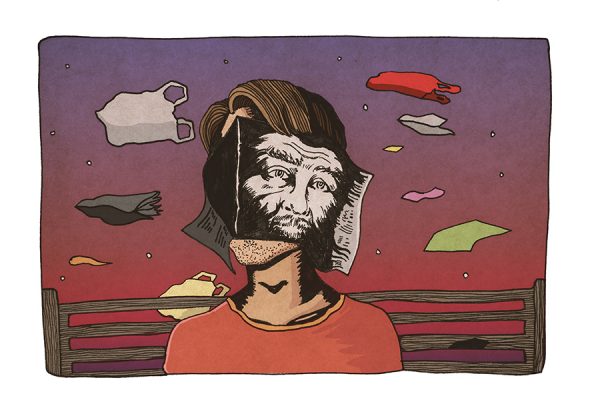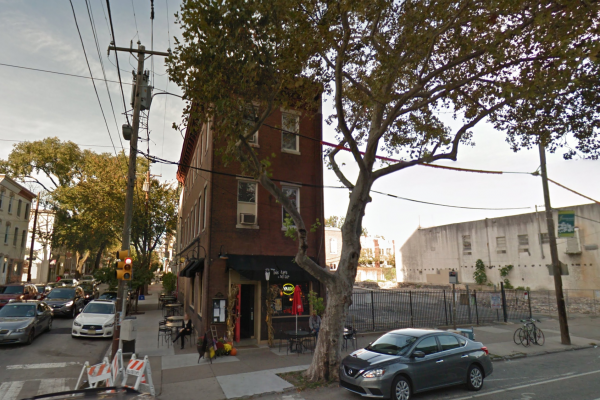“The Porch”, a little known film about life in Philadelphia in the year 1955, surfaced recently. A friend of mine announced its discovery when he found it among his old VHS tapes. The film, as it turned out, seemed to be in fine condition. While I had never heard of the film, I was very curious to see what it portrayed.
When my friend Zorro started the film, I could see right away that the production quality was not very high. The images in the old black and white film had a faded, bleached out look.
“The Porch” opens with a row house patio scene. At first, it’s not clear where the patio is located. I assumed it was South Philadelphia, but on closer inspection I was pleased to see that it was somewhere in the Riverwards. In an almost modernist way, the camera focuses on just the empty patio and keeps rolling although there is no action. Finally, we see a cat running from one end of the patio to the other. No doubt this animal is chasing a bird. After this nothing happens for a while, a Mummer, decked out in feathers and a cape, eventually struts in front of the camera.
The Mummer’s cape is far humbler and simpler looking than today’s costumes. The Mummer has a heavily painted face and dances from one end of the patio to the other. All of this happens without any music. He just keeps dancing and dancing, going forward and backwards and then twirling around in this very small patio where occasionally you can see the rooftops of other row homes in the area.
What struck me initially was that there was no dialogue. I wanted a script, a story. But even as the film progressed, there were only a series of kaleidoscopic images, namely of women lying in the sun. Who were these women? Some of them wore head bandanas and looked like Rosie the Riveter. It became clear that they were women of the neighborhood. Mothers, daughters and grandmothers — the women of 1955.
Suddenly a narrator’s voice is heard.
“The sun is warm and life is good,” he says. The voice belongs to John Facenda. When the camera pans skyward a Budweiser billboard pops into view, and then Facenda’s voice resumes. “In Philadelphia, there’s always something to make you stop crying.”
The thing is, nobody in the film was crying until a baby in a cradle appears on screen. The baby was indeed crying, shaking its little fingers while crunching up its nose and moving its head from side to side. Once again, Facenda’s voice is heard. “You’re crying…well, you may have your reasons but think of all the fun that lies ahead.”
“These were really optimistic times,” I said to Zorro. “They had no idea that Vietnam was just down the pike. Or that the assassination of a future President was in the wings. It’s good we don’t know what the future holds.”
I no sooner said this then the images on screen seemed very familiar to me. Yes, by God, I was really seeing Aramingo Avenue in 1955. But not only Aramingo Avenue, but East Huntingdon Street, Richmond Street and many smaller streets in my immediate neighborhood. The camera seemed to be on a topography tirade as it scanned the inside of the old paint factory that stood at Huntingdon and Thompson Streets. There in front of me were workers in endless assembly lines. More close-ups of the streets—all meticulously spotless without a shred of litter, mind you — then the Mummer appeared again and proceeded to dance up towards York Street, twirling and twirling until he disappeared like a dot on the horizon.
O Poor Mummer, I thought, where are you now?
The camera then panned Lehigh Avenue where I caught a glimpse of the houses I still see standing today. I recognized windows and doors. There seemed to be a lot more parking spaces in 1955 and people were better dressed. No sweat suits and baseball caps. The women wore hats and many of the men wore baggy jackets and ties. Sometimes the suits were so baggy the men looked like clowns.
Life seemed so formal then.
The film then showed a Strawberry Mansion bound Route 39 Peter Witt Streetcar appeared on Huntingdon at Richmond Street. Ah, the beauty of Richmond Street prior to I-95! Children played on the stoops of the row houses there as Chrysler New Yorkers and a Chevrolet Bel Air and Corvette slowly drove by. In two years, the highly eccentric looking Ford Edsel would make its way down Richmond. How many people in the Riverwards would buy an Edsel?
“Everything was ruined by I-95,” Zorro observed.
The route 39 appeared again, stopping to pick up two women in long dresses. Were they going into Center City to visit Horn & Hardart or Stouffer’s? A man in a bowler hat wobbled into view from a side street–did he just leave one of the bars along Lehigh Avenue?—just as two kids in a homemade go-kart came barreling around the corner, almost crashing into a lamppost.
Above a small corner store I spot a Camel cigarette ad, and beside that is a faded billboard featuring Marilyn Monroe.
A Cadillac convertible passes in front of the camera with an Adlai Stevenson for President bumper sticker. That’s when I remember that the country was gearing up for the November 6, 1956 presidential elections, when Dwight D. Eisenhower would beat Stevenson by almost 9 million votes. The 1956 election was the last presidential election in which both major candidates were born in the 19th century.
Then, in a very shocking scene reminiscent of contemporary behavior patterns, a man and a woman appear out of a house on Richmond with Eisenhower signs and proceed to chase after the Cadillac. They appear to be shouting slogans when one of them drops their sign as both manage to jump on the trunk of the Cadillac. They pound the car furiously with their fists. The Cadillac brakes, then speeds up, and then brakes again in an attempt to throw them off the car. Eventually the motion does send the couple sailing across Richmond Street where they land in the gutter, unhurt but apparently dazed.
“Election animosity is as old as the hills,” I mumble, as Facenda’s voice suddenly emerges, pleading for tolerance and unity.
By now I am very engrossed in this film, and ask Zorro why it’s never been shown on public television. “The Porch” isn’t even on YouTube, as far as I know, and it might even be virtually invisible except for random showings by private collectors.
Perhaps the most eerie thing about “The Porch” is that so many of the characters who appear in the film, especially after the political attack scene, closely resemble the faces of neighbors and people I see today walking in the area.
“Really, they seem to be the very same people,” I said, lurching forward in my chair and pointing to a face that was a dead ringer of a local business owner.
“It can’t be him,” Zorro said. “The film is from 1955.”
But sightings of duplicate people only increased after the camera panned to a shopping crowd scene near Girard Avenue. That’s when the huddled masses on the street going about their errands were none other than the very people I see every week in the Riverwards. I spotted Citizen’s Bank employees, Washington Bank employees, Stock’s Bakery employees and more. All of them in 1950s dress and going about their business as they do today, 70 years later. “They’re living two lives at once,” I told Zorro, “one in an archival film and the other in 2016.”
“The more things change, the more they stay the same,” I muttered, reaching for the popcorn.
I really flipped when I began to see the faces of the neighbors on my street.
“How is this possible?” I said to Zorro.
I soon stopped asking how this was possible but started to wonder how I could step inside the film to find out what was going on. Certainly such a thing was possible. I knew I had to find a way to do it in order to warn these folks about I-95 (“Don’t let them build the wall!”) and to tell that fanatical Eisenhower couple that their fighting was not needed because Eisenhower would win anyway.
But this would only be the beginning. I’d have a lot of other news and predictions to deliver even if nobody wanted to hear about the future.
Once again the camera panned the face of the baby in a cradle. The baby was still crying and moving its little hands as John Facenda repeated, “The sun is good and life is good.” •






